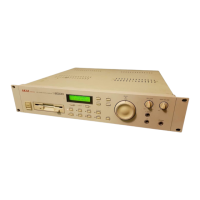
Do you have a question about the Akai s2000 and is the answer not in the manual?
| Type | Sampler |
|---|---|
| Polyphony | 32 voices |
| Sampling Frequency | 44.1kHz |
| Filters | Digital low-pass filter |
| MIDI | In, Out, Thru |
| Bit Depth | 16-bit |
| Memory | 2 MB, expandable to 32 MB |
| Outputs | 8 individual outputs, stereo master output |
| LFO | 1 LFO |
| Display | LCD |
| Storage | 3.5" Floppy Disk |
| Inputs | Stereo input |
Guidelines to prevent fire, shock hazards, and ensure safe operation of the S2000.
Details of the product warranty period, coverage, and service procedures.
Detailed list of S2000 features including polyphony, memory, and I/O.
Description of controls, displays, and connectors on the front and rear panels.
Overview of the different operating modes: Single, Multi, Sample, Effects, Edit, Global, Save, Load.
Steps for connecting peripherals and powering up the S2000.
Procedures for loading sounds from disk and playing the demo sequence.
Explanation of samples, programs, keygroups, and modulation.
Steps for loading data from floppy and hard disks.
Loading multis, programs, samples, or individual items.
Loading OS and sounds from other manufacturers' disks.
Procedure for saving all data to floppy or hard disk.
Saving multis, programs, samples, and operating systems.
Deleting files from disk and naming disk volumes.
Playing, renumbering, and deleting programs in Single mode.
Creating layered sounds and multi-timbral setups in Single mode.
Comparing the advantages and disadvantages of Single and Multi modes.
Assigning programs to parts and modifying multi parameters.
Setting MIDI channels, levels, pan, and output routing for parts.
Combining techniques for layering sounds and creating keyboard splits.
Keygroup definition, zones, and sample assignment.
Editing filter parameters and using envelope generators (ENV1, ENV2, ENV3).
Using LFOs, APM, and pitch bend for sound modulation.
Editing sample parameters like velocity, loops, and timestretch.
Removing dead space and optimizing sample levels.
Creating loops, tuning loops, and using crossfade looping.
Optimizing memory with re-sampling and altering sample length with timestretch.
Description of the 4-channel effects processor and its channels.
Editing parameters for delay, reverb, chorus, flange, and phase effects.
Adjusting EQ, rotary speaker, and autopan effects.
Using pitch shift, chaining effects, and routing options.
Configuring MIDI channels, controllers, and SCSI ID.
Formatting disks and managing disk operations.
Using DAT for backup and playing SMF files.
Guide to connecting SCSI devices and understanding SCSI cable requirements.
Information on compatibility with older Akai sampler data formats.
Instructions for installing optional hardware like filters, effects, and memory.
Detailed technical specifications and MIDI implementation chart.